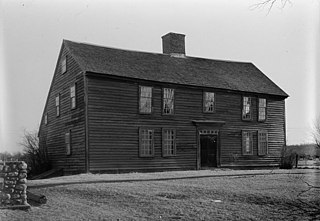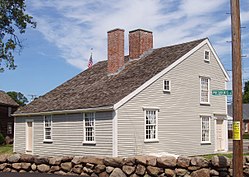
Abigail Adams was the wife and closest advisor of John Adams, as well as the mother of John Quincy Adams. She was a founder of the United States, and was both the first second lady and second first lady of the United States, although such titles were not used at the time. She and Barbara Bush are the only two women to have been married to U.S. presidents and to have been the mothers of other U.S. presidents.

Charles Francis Adams Sr. was an American historical editor, writer, politician, and diplomat. As United States Minister to the United Kingdom during the American Civil War, Adams was crucial to Union efforts to prevent British recognition of the Confederate States of America and maintain European neutrality to the utmost extent. Adams also featured in national and state politics before and after the Civil War.

A saltbox house is a gable-roofed residential structure that is typically two stories in the front and one in the rear. It is a traditional New England style of home, originally timber framed, which takes its name from its resemblance to a wooden lidded box in which salt was once kept.

The Hancock–Clarke House is a historic house in Lexington, Massachusetts, which is now a National Historic Landmark. Built in 1738, the house is notable as the only surviving house associated with statesman and Founding Father John Hancock, who lived here for several years as a child. It played a prominent role in the Battle of Lexington and Concord as both Hancock and Samuel Adams, leaders of the colonials, were staying in the house before the battle. The House is operated as a museum by the Lexington Historical Society. It is open weekends starting in mid-April and daily from May 30–October 31. An admission fee is charged.

Adams National Historical Park, formerly Adams National Historic Site, in Quincy, Massachusetts, preserves the home of United States presidents John Adams and John Quincy Adams, of U.S. envoy to Great Britain, Charles Francis Adams, and of writers and historians Henry Adams and Brooks Adams.

The John Adams Birthplace is a historic house at 133 Franklin Street in Quincy, Massachusetts. It is the saltbox home in which Founding Father and second president of the United States, John Adams, was born in 1735. The house was designated a National Historic Landmark in 1960, and is listed on the National Register of Historic Places. It is now administered by the National Park Service as part of the Adams National Historical Park, and is open for guided tours.

United First Parish Church is an American Unitarian Universalist congregation in Quincy, Massachusetts, established as the parish church of Quincy in 1639. The current building was constructed in 1828 by noted Boston stonecutter Abner Joy to designs by Alexander Parris. The building was designated a National Historic Landmark on December 30, 1970, for its association with the Adams family, who funded its construction and whose most significant members are interred here.

Peacefield, also called Peace field or Old House, is a historic home formerly owned by the Adams family of Quincy, Massachusetts. It was the home of United States Founding Father and U.S. president John Adams and First Lady Abigail Adams, and of U.S. president John Quincy Adams and his First Lady, Louisa Adams. It is now part of the Adams National Historical Park.

The Boardman House, also known as the Scotch-Boardman House or the Bennett-Boardman House, is a historic house located at 17 Howard Street, Saugus, Massachusetts. Built in 1692, it was designated a National Historic Landmark in 1961 because of the remarkable amount of original building material still present in the house. It has been owned by Historic New England since 1914, and is open to the public on select weekends between June and October.

Carpenters' Hall is the official birthplace of the Commonwealth of Pennsylvania and a key meeting place in the early history of the United States. Carpenters' Hall is located in Independence National Historical Park in Philadelphia, Pennsylvania.

The Massachusetts Historical Society (MHS) is a major historical archive specializing in early American, Massachusetts, and New England history. The Massachusetts Historical Society was established in 1791 and is located at 1154 Boylston Street in Boston, Massachusetts, and is the oldest historical society in the United States.

The Huntington Homestead, also known as the Samuel Huntington Birthplace, is a historic house museum and National Historic Landmark at 36 Huntington Road in Scotland, Connecticut. Built in the early 18th century, it was the birthplace and boyhood home of Samuel Huntington (1731–1796), an American statesman and Founding Father. He served as a delegate to the Continental Congress, where he signed the Declaration of Independence. He also served as Governor of Connecticut and was the first presiding officer of the Congress of the Confederation, the first central government of the United States of America.

The John Paul Jones House is a historic house at 43 Middle Street in Portsmouth, New Hampshire. Now a historic house museum and a National Historic Landmark, it is where American Revolutionary War naval hero John Paul Jones, resided from 1781-82 when it was operated as a boarding house. He also lived in a home in Fredericksburg, Virginia, on Caroline Street, owned by his brother.

Adams Academy was a school that opened in 1872 in Quincy, Massachusetts, United States. John Adams, the second President of the United States, had many years before established the Adams Temple and School Fund. This fund gave 160 acres (0.65 km2) of land to the people of Quincy in trust. His objective for the money was to build a school in honor of his friends John Hancock and Josiah Quincy, who, like Adams, lived in the town of Quincy, Massachusetts. John Hancock's birth place had been on the land.

The John Whipple House is a historic colonial house at 1 South Green in Ipswich, Massachusetts. Built in the seventeenth century, the house has been open to the public as a museum since 1899 and was the subject of some of the earliest attempts at the preservation of colonial houses. It was designated a National Historic Landmark in 1960, one of the earliest properties to receive that honor.

The John Ward House is a National Historic Landmark at 9 Brown Street in Salem, Massachusetts, United States. With an early construction history between 1684 and 1723, it is an excellent example of First Period architecture, and as the subject of an early 20th-century restoration by antiquarian George Francis Dow, it is an important example of the restoration techniques. Now owned by the Peabody Essex Museum, it is also one of the first colonial-era houses in the United States to be opened as a museum. It was designated a National Historic Landmark in 1968.

The Dorothy Quincy Homestead is a US National Historic Landmark at 34 Butler Road in Quincy, Massachusetts. The house was originally built by Edmund Quincy II in 1686 who had an extensive property upon which there were multiple buildings. Today, the site consists of the Dorothy Quincy Homestead, which has been preserved as a museum and is open occasionally to the public.
John Adams Sr., also known as Deacon John, was a British-North American colonial farmer and minister. Adams was the father of the second U.S. president, John Adams Jr., and paternal grandfather of the sixth president, John Quincy Adams. He was the son of Joseph Adams Jr. (1654–1737), the grandson of Joseph Adams (1626–1694), and the great-grandson of Henry Adams, who emigrated from Braintree, Essex, in England to Massachusetts Bay Colony in about 1638. His other ancestors include John and Priscilla Alden. Adams worked as a farmer and cobbler for most of his life.























